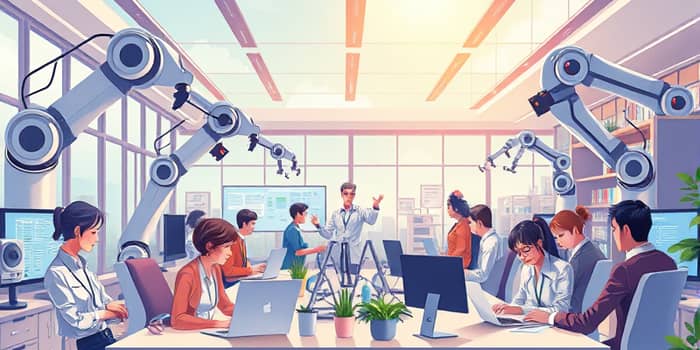The dawn of intelligent machines is transforming every corner of our economy. As automation and AI become more capable, they promise to reshape industries, redefine roles, and unlock unprecedented productivity gains. Yet, this transformation also raises important questions about job displacement, wage inequality, and policy readiness. In this article, we explore the latest data, practical strategies, and a vision for a future where humans and machines thrive together.
By understanding key trends and preparing proactively, organizations and individuals can harness automation’s potential while mitigating its risks. The journey ahead demands adaptation, lifelong learning, and bold leadership.
Key Statistics and Projections
Recent forecasts suggest that automation and AI could contribute approximately $13 trillion to global economic activity by 2030, boosting cumulative GDP by 16 percent compared to today. Nearly 40 percent of jobs worldwide will be affected, with advanced economies potentially seeing up to 60 percent of roles touched by AI.
However, these figures mask regional variations. Low-income countries may experience only 26 percent exposure, while emerging markets hover around 40 percent. Understanding this landscape is crucial for policymakers and business leaders crafting tailored strategies.
Labor Market Impacts
Automation’s effects on the labor market are nuanced. While some roles will be fully automated, others will see AI augment human capabilities. Studies suggest that for half of the affected roles, AI will enhance worker productivity rather than replace them. Yet, the remaining roles will face potentially lowering labor demand, wages, and hiring, particularly in sectors like manufacturing and accounting.
- For every robot added per 1,000 U.S. workers, wages decline by 0.42 percent, and employment-to-population ratios drop by 0.2 points.
- One robot per 1,000 workers correlates with a net loss of about 3.3 jobs nationwide.
- Global estimates from Goldman Sachs indicate AI could replace the equivalent of 300 million full-time positions.
These shifts underscore the need for agile workforce planning and targeted reskilling efforts. Younger employees may adapt more quickly to new tools, while seasoned professionals could face steeper learning curves.
Workplace Transformation and Inequality
As offices and factories integrate smart machines, workspaces will evolve. Design changes may include separate zones for robots and humans, collaborative stations with shared interfaces, and flexible layouts that support both physical and digital tasks. This democratize skills and increase productivity across diverse roles, from healthcare to logistics.
Yet automation also risks deepening income divides. High-skill, high-wage workers who can leverage AI stand to gain disproportionate benefits, while mid- and low-wage workers may face stagnation. Historical parallels, like the "Engels’ Pause" during the Industrial Revolution, remind us that productivity spikes do not automatically translate into broad-based wage growth.
- Educated white-collar professionals earning up to $80,000 annually are among the most exposed to automation.
- Capital owners and high-income workers often reap the largest productivity dividends.
- Countries with robust infrastructure and skilled workforces may accelerate ahead, widening global inequality.
Policy and Adaptation Challenges
Governments and businesses must act swiftly to ensure automation uplifts societies rather than undermines them. Studies show that if displaced workers find new employment within one year, automation can drive overall growth, sustain full employment, and raise wages. Delays, however, can lead to prolonged unemployment and slower wage gains.
- Boost funding for lifelong training and digital literacy programs.
- Implement rapid reemployment services and transition assistance.
- Encourage public–private partnerships to align curricula with emerging skill demands.
Alarmingly, spending on worker education and transition assistance has declined across OECD countries over the past two decades. Without decisive policy interventions, the social and economic costs of automation could outweigh its benefits.
Charting a Path Forward
Despite the challenges, automation offers a transformative opportunity. By embracing continuous learning, fostering collaboration between humans and machines, and advocating for inclusive policies, stakeholders can create a future of work that is both prosperous and equitable.
Organizations can pilot mentorship programs where experienced employees teach AI fluency to peers, while governments might incentivize companies to invest in on-the-job training. Individuals, for their part, can cultivate a growth mindset, seek cross-functional projects, and stay abreast of emerging technologies.
Ultimately, our collective response to automation will define the economic and social landscape for generations. By prioritizing adaptability, empathy, and innovation, we can ensure that the next chapter of work delivers opportunity and dignity for all.
References
- https://www.mckinsey.com/featured-insights/future-of-work/jobs-lost-jobs-gained-what-the-future-of-work-will-mean-for-jobs-skills-and-wages
- https://www.aei.org/research-products/report/navigating-the-future-of-work-perspectives-on-automation-ai-and-economic-prosperity/
- https://www.commerce.nc.gov/news/the-lead-feed/generative-ai-and-future-work
- https://www.imf.org/en/Blogs/Articles/2024/01/14/ai-will-transform-the-global-economy-lets-make-sure-it-benefits-humanity
- https://www.mckinsey.com/featured-insights/future-of-work/ai-automation-and-the-future-of-work-ten-things-to-solve-for
- https://mitsloan.mit.edu/ideas-made-to-matter/a-new-study-measures-actual-impact-robots-jobs-its-significant
- https://www.nexford.edu/insights/how-will-ai-affect-jobs
- https://equitablegrowth.org/exploring-the-impact-of-automation-and-new-technologies-on-the-future-of-u-s-workers-and-their-families/










